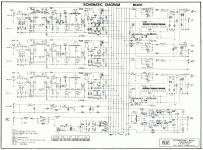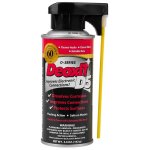Hi All,
I am currently fixing a Rotel RA-930AX. It now seems to be working fine, apart from a slight crackle on the left channel which is evident only when i turn the balance dial to the left. I have cleaned this multiple times using Servisol 10, but the problem remains. I have read online that Deoxit may be better to use, as it removes the oxidation on the fader, as well as cleans. However, there is also some debate over which deoxit to use. Some videos say use D5, while others say F5. Any advice? Would switching from servisol to deoxit likely fix this issue, or do i need to get in there an take the potentiometer apart to clean it properly? Thanks!
I am currently fixing a Rotel RA-930AX. It now seems to be working fine, apart from a slight crackle on the left channel which is evident only when i turn the balance dial to the left. I have cleaned this multiple times using Servisol 10, but the problem remains. I have read online that Deoxit may be better to use, as it removes the oxidation on the fader, as well as cleans. However, there is also some debate over which deoxit to use. Some videos say use D5, while others say F5. Any advice? Would switching from servisol to deoxit likely fix this issue, or do i need to get in there an take the potentiometer apart to clean it properly? Thanks!
To expand on TomChr's post:
For a potentiometer, you have to worry about both cleaning the oxidation and accumulated dust/crud/contact shavings (if the design incorporates that feature); and lubricating the contact between the resistance element and the sliding contact. D5 is for cleaning, and Faderlube is for lubricating the resistance element/contact.
For a potentiometer, you have to worry about both cleaning the oxidation and accumulated dust/crud/contact shavings (if the design incorporates that feature); and lubricating the contact between the resistance element and the sliding contact. D5 is for cleaning, and Faderlube is for lubricating the resistance element/contact.
Just finished servicing a 70's/80's stage mixer (Ross 16x2) with 16 x 7 + 6 =118 pots (all the faders were ok).
Most pots were stuck. Had to take out all the boards (19), assemble everything again and had some mech issues to address too.
Two weeks on the desk.
Sequence involved: IPA, IPA, contact 60 spray (nasty stuff), IPA, IPA, IPA, & finally "5-56+PTFE" (by CRC) for the lub, acts inert.
All working, no added noise, cracklings or otherwise.
Modified the odd Mon output (why adding the SUM signal???) to a regular Mon output pot (a half TL072 was unused, now a buffer).
Maybe changing the Sum jack output to an insert to enable freq adjustment (from 'sum' to 'sub'!) by a channel line/insert config.
For sale now (50 is ok).
Most pots were stuck. Had to take out all the boards (19), assemble everything again and had some mech issues to address too.
Two weeks on the desk.
Sequence involved: IPA, IPA, contact 60 spray (nasty stuff), IPA, IPA, IPA, & finally "5-56+PTFE" (by CRC) for the lub, acts inert.
All working, no added noise, cracklings or otherwise.
Modified the odd Mon output (why adding the SUM signal???) to a regular Mon output pot (a half TL072 was unused, now a buffer).
Maybe changing the Sum jack output to an insert to enable freq adjustment (from 'sum' to 'sub'!) by a channel line/insert config.
For sale now (50 is ok).
Attachments
Does IPA stands for isopropyl alcohol ??
And I did use De-Ox-Id from GC chemical but when I try to get more of that stuff I foud Deoxit D5 from Caig quite cunfusing.
And I did use De-Ox-Id from GC chemical but when I try to get more of that stuff I foud Deoxit D5 from Caig quite cunfusing.
IPA Isopropyl Alcohol
IPA India Pale Ale (Also an alcohol, but not used for cleaning potentiometers. Can be used for soothing Technician. )
IPA India Pale Ale (Also an alcohol, but not used for cleaning potentiometers. Can be used for soothing Technician. )
Yep. So give the pot a squirt of D5, exercise it, and let it dry. Then a squirt of Faderlube followed by exercise.For a potentiometer, you have to worry about both cleaning the oxidation and accumulated dust/crud/contact shavings (if the design incorporates that feature); and lubricating the contact between the resistance element and the sliding contact. D5 is for cleaning, and Faderlube is for lubricating the resistance element/contact.
Tom
And I did use De-Ox-Id from GC chemical but when I try to get more of that stuff I foud Deoxit D5 from Caig quite cunfusing.
You want the real deOxit D5, not a copy.
I use a syringe to spray Iso Alcohol, and work the pots, watch what comes out...
Then repeat if really dirty.
Blow off with air if the shafts or tracks look like plastic, alcohol can cause damage to them at times.
Then spray CRC 2-26 as cleaner / lubricant.
Before you all say that is wrong:
Most of these switch cleaning / maintenance compounds have a base of hydro treated naptha, aka transformer oil, and it is only the additive package (and smell) which is slightly different among them...
The USA requires that the item's MSDS be submitted to their government, so it is easy to compare, if you know the language used as chemical names.
Just search for and download the MSDS, it is usually within three pages in length for this purpose.
Then repeat if really dirty.
Blow off with air if the shafts or tracks look like plastic, alcohol can cause damage to them at times.
Then spray CRC 2-26 as cleaner / lubricant.
Before you all say that is wrong:
Most of these switch cleaning / maintenance compounds have a base of hydro treated naptha, aka transformer oil, and it is only the additive package (and smell) which is slightly different among them...
The USA requires that the item's MSDS be submitted to their government, so it is easy to compare, if you know the language used as chemical names.
Just search for and download the MSDS, it is usually within three pages in length for this purpose.
I agree, get the original. Others often clean very well too but don't contain lubricant, Caig DeoxIT D5S-6-LMH does.
For emergency repairs: If you don't have the right cleaner, you can still use aggressive contact spray, clean/flush it out with alcohol + window cleaner and use a lubricant afterwards - if you are careful where each one of them goes and contain the area.
For emergency repairs: If you don't have the right cleaner, you can still use aggressive contact spray, clean/flush it out with alcohol + window cleaner and use a lubricant afterwards - if you are careful where each one of them goes and contain the area.
Use as little cleaner as you can. Every single cleaner out there attacks all lubricants. What gets noisy is the wiper to slip ring or bar (linear faders). That's metal. Use a zero residue contact cleaner. Anything else tends to gum things up.
There are different cleaners depending on what type of oxides you have. I get my different ones from Industrial and the Aerospace industry.
Ever feel a sloppy control shaft? That comes from too much cleaner, it washes out the lubricants in the bushing, then wears over time. Then it is too late, control trashed. The protective grease on the carbon track is - grease. Cleaners do not have grease in them, TV tuner cleaners did, but also abrasives.
There are different cleaners depending on what type of oxides you have. I get my different ones from Industrial and the Aerospace industry.
Ever feel a sloppy control shaft? That comes from too much cleaner, it washes out the lubricants in the bushing, then wears over time. Then it is too late, control trashed. The protective grease on the carbon track is - grease. Cleaners do not have grease in them, TV tuner cleaners did, but also abrasives.
https://www.amazon.com/CAIG-Laboratories-D5S-6-LMH-Contact-Low-Med-High/dp/B08N39YQMP/ref=sr_1_2D5,G5,F5....what are all these?
Well put!IPA India Pale Ale (Also an alcohol, but not used for cleaning potentiometers. Can be used for soothing Technician. )
Also remember that any DC on a control can cause all manner of noise and static. Make sure your coupling capacitors aren't leaky! You can clean forever and it won't solve the problem if the coupling caps are bad.
Thanks but I mean what's are the differences between the D5,G5,F5?
Make certain the type of top is taken under consideration for the Caig products. For example, the top pictured below leaks and becomes loose over time, to the point that you have to glue it back on in certain circumstances. You'll save a lot of product with the classic/original spray tip that Rayma links to above. It looks like they've switched back and hopefully permanently.
Attachments
- Home
- Amplifiers
- Solid State
- Which contact cleaner to use? Getting very different advice online

